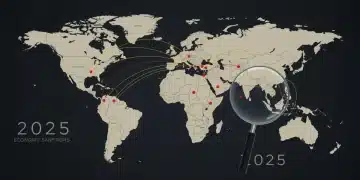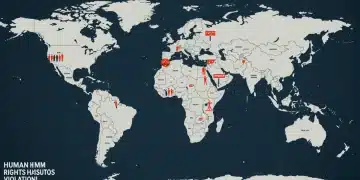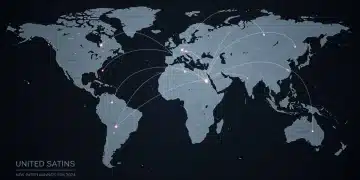Geopolitical Chessboard 2025: US Foreign Policy Shifts

The US foreign policy landscape in 2025 is undergoing significant transformations driven by intensified great power competition, rapid technological advancements, and the escalating impacts of climate change, demanding strategic adaptations from Washington.
As 2025 approaches, US foreign policy 2025 is at a critical juncture, navigating an increasingly complex global environment. Recent updates and insider knowledge reveal significant power shifts that are fundamentally reshaping America’s approach to international relations. This analysis delves into the three key areas demanding immediate attention and strategic recalibration from Washington.
The Resurgence of Great Power Competition
The global stage is witnessing a marked return to great power competition, a dynamic that profoundly influences US foreign policy in 2025. This involves not only traditional military rivalries but also economic, technological, and ideological contests. The United States finds itself recalibrating alliances and strategies to counter assertive actions from revisionist powers, particularly China and Russia, as they seek to reshape the international order.
This competition is multifaceted, extending into various domains. From military posturing in contested regions to economic coercion and influence operations, the landscape is more volatile than in decades. Washington’s response involves strengthening partnerships, bolstering defense capabilities, and leveraging economic tools to maintain its strategic advantage and uphold democratic values globally.
China’s Assertive Rise and US Counter-Strategies
China’s economic and military expansion continues to be a primary driver of geopolitical shifts. Its Belt and Road Initiative, coupled with advancements in military technology and territorial claims in the South China Sea, present direct challenges to US interests and regional stability. The US response focuses on building resilient supply chains, fostering economic alternatives for developing nations, and reinforcing security alliances in the Indo-Pacific.
- Economic Decoupling: Efforts to reduce reliance on Chinese supply chains and promote domestic production in critical sectors.
- Technological Rivalry: Competition for dominance in AI, quantum computing, and semiconductors, with export controls and investment screening.
- Alliance Reinforcement: Strengthening partnerships with Japan, South Korea, Australia, and India to counterbalance Chinese influence.
The strategic competition with China requires a delicate balance of cooperation on global issues like climate change, while robustly confronting actions that undermine international norms and security. This dual approach is central to US foreign policy in 2025.
Russia’s Enduring Challenge and European Security
Russia’s ongoing aggression in Eastern Europe continues to destabilize the continent and challenge the post-Cold War security architecture. The US, alongside NATO allies, remains committed to supporting Ukraine and deterring further Russian expansion. This involves significant military aid, economic sanctions, and reinforcing NATO’s eastern flank.
- NATO Unity: US leadership in maintaining alliance cohesion and readiness against Russian threats.
- Sanctions Regime: Sustained economic pressure targeting key Russian sectors and individuals.
- Energy Security: European efforts, supported by the US, to reduce dependence on Russian energy sources.
The long-term implications of the conflict in Ukraine continue to shape European security, making the US role in bolstering trans-Atlantic ties and collective defense paramount. This enduring challenge necessitates a coherent and sustained US foreign policy in 2025 that prioritizes deterrence and diplomatic solutions.
In conclusion, the resurgence of great power competition demands a comprehensive and agile US foreign policy. Washington is actively engaging on multiple fronts, from economic statecraft to military deterrence, to safeguard its interests and promote a stable, rules-based international order against increasingly assertive rivals.
Technological Disruption and Cyber Warfare
Technological disruption is not merely an economic phenomenon but a profound geopolitical force, fundamentally altering the landscape of US foreign policy in 2025. Advances in artificial intelligence, quantum computing, biotechnology, and advanced materials are creating new avenues for power projection and vulnerabilities. Cyber warfare, in particular, has emerged as a pervasive threat, capable of undermining national security, critical infrastructure, and economic stability.
The race for technological supremacy is now inextricably linked to national security. Nations are investing heavily in research and development, while simultaneously seeking to protect their intellectual property and defend against state-sponsored cyber espionage and attacks. This digital battleground requires innovative defensive strategies and proactive international cooperation.
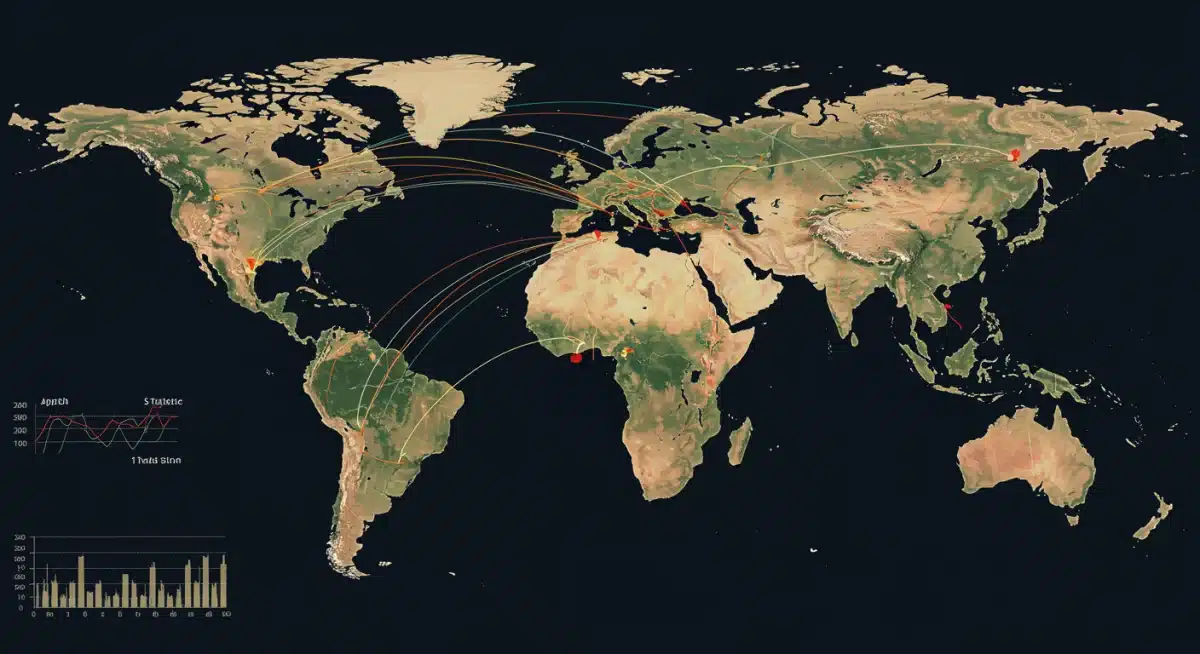
The AI Race and Geopolitical Implications
The rapid development of artificial intelligence (AI) is sparking an intense global competition, with profound implications for military capabilities, economic productivity, and societal control. The US recognizes AI as a critical component of its future power and is investing significantly in research, ethical frameworks, and regulatory policies. The concern is not just about who develops the most advanced AI, but also about how it is used and who controls its applications.
AI’s dual-use nature means it can enhance defense systems but also be weaponized, raising questions about autonomous weapons and decision-making in warfare. US foreign policy in 2025 is grappling with how to foster responsible AI development among allies while preventing adversaries from gaining an unfair advantage.
Cybersecurity as a National Security Imperative
Cyber attacks have become a constant feature of international relations, targeting governments, corporations, and critical infrastructure. From ransomware attacks on pipelines to espionage targeting sensitive data, the economic and security costs are enormous. The US is enhancing its cyber defenses, investing in threat intelligence, and working with international partners to establish norms for responsible state behavior in cyberspace.
- Critical Infrastructure Protection: Implementing robust cybersecurity measures for sectors like energy, finance, and healthcare.
- International Norms: Advocating for global agreements on cyber warfare and accountability for state-sponsored attacks.
- Talent Development: Investing in cybersecurity education and training to build a skilled workforce.
The interconnectedness of the digital world means that a cyber attack in one nation can have ripple effects globally. Therefore, collaborative efforts to share threat intelligence and develop collective response mechanisms are vital for US foreign policy in 2025. Protecting digital sovereignty and ensuring a free and open internet are key objectives in this evolving domain.
Ultimately, navigating technological disruption and cyber warfare requires a multi-pronged approach that combines domestic innovation, robust defense, and proactive international engagement. The US aims to lead in setting global standards for technology governance and responsible cyber behavior, ensuring these advancements serve humanity rather than destabilize it.
Climate Change as a Foreign Policy Priority
Climate change is no longer solely an environmental issue; it is a profound national security and foreign policy challenge that directly impacts US foreign policy in 2025. Its effects, including extreme weather events, resource scarcity, and mass displacement, exacerbate existing instabilities and create new ones. Washington is increasingly integrating climate considerations into its diplomatic, defense, and development strategies.
The US recognizes that addressing climate change requires global cooperation. No single nation can solve this crisis alone. This necessitates renewed engagement in international climate forums, fostering green technology partnerships, and supporting vulnerable nations in their adaptation and mitigation efforts. The economic and human costs of inaction are too high to ignore.
Resource Scarcity and Migration Pressures
Climate change intensifies resource scarcity, particularly water and arable land, leading to increased competition and potential conflict. In regions already prone to instability, such as parts of Africa and the Middle East, these pressures can fuel internal strife and cross-border tensions. Additionally, climate-induced natural disasters and long-term environmental degradation are projected to trigger significant human migration, creating humanitarian crises and geopolitical challenges.
US foreign policy in 2025 must proactively address these emerging threats. This includes diplomatic initiatives to resolve resource disputes, humanitarian aid for displaced populations, and investment in sustainable development practices to build resilience in affected communities. Understanding the nexus between climate, resources, and migration is crucial for effective policy.
Green Technology Diplomacy and Energy Transition
The transition to a global green economy presents both challenges and opportunities for US foreign policy. Promoting renewable energy technologies, sustainable infrastructure, and climate-resilient development can foster economic growth, create new markets, and reduce reliance on fossil fuels, which often originate from volatile regions. The US is leveraging its technological prowess to drive this transition, both domestically and internationally.
- Climate Finance: Mobilizing capital for climate projects in developing nations and supporting adaptation efforts.
- Technology Transfer: Sharing expertise and accelerating the adoption of clean energy solutions globally.
- Bilateral Agreements: Forging partnerships with key nations to advance shared climate goals and reduce emissions.
Green technology diplomacy is becoming a cornerstone of US engagement, offering a pathway to strengthen alliances and promote a more sustainable global future. This shift is not just about environmental protection, but also about securing future energy independence and economic competitiveness, fundamentally influencing US foreign policy in 2025.
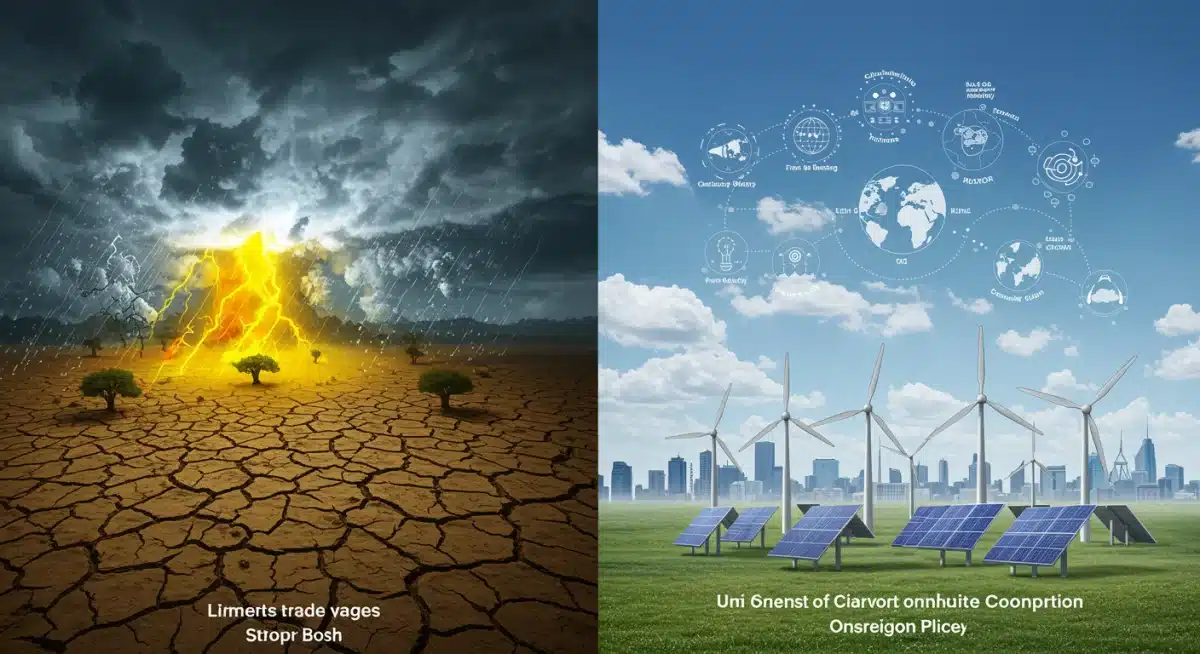
In summary, climate change has ascended to a top-tier foreign policy concern, demanding integrated and collaborative solutions. The US is positioning itself to lead international efforts, recognizing that global environmental stability is intrinsically linked to its national security and prosperity.
The Evolving Role of Multilateral Institutions
In an era defined by complex global challenges, the efficacy and relevance of multilateral institutions are under intense scrutiny, significantly impacting US foreign policy in 2025. While some question their ability to address contemporary crises, others argue for their renewed importance in fostering cooperation and managing international disputes. The US approach involves a strategic re-engagement with these bodies, seeking to reform and revitalize them to better serve collective interests.
From the United Nations to the World Health Organization and the World Trade Organization, these institutions face pressures from great power rivalries, internal inefficiencies, and a crisis of legitimacy. Washington’s strategy aims to reinforce their foundational principles while pushing for necessary modernizations to ensure they remain fit for purpose in the 21st century.
Reforming Global Governance Structures
Many global governance structures were established in a post-World War II context that no longer fully reflects today’s distribution of power or the nature of current threats. The US is advocating for reforms that would make institutions like the UN Security Council more representative and agile. This includes discussions on expanding membership and updating decision-making processes to include emerging powers more effectively.
Such reforms are critical for enhancing the legitimacy and effectiveness of these bodies. Without them, there is a risk of fragmentation, with nations opting for bilateral agreements or smaller, exclusive blocs, undermining the very concept of collective security and global problem-solving. This push for reform is a key element of US foreign policy in 2025.
Strengthening Alliances and Partnerships
Beyond formal multilateral organizations, the US is also intensifying its efforts to strengthen existing alliances and forge new partnerships. These alliances, whether bilateral or minilateral (small groups of states), serve as crucial pillars of US foreign policy, providing platforms for coordinated action on shared security, economic, and climate goals. Examples include the Quad (US, Australia, India, Japan) and AUKUS (Australia, UK, US).
- NATO’s Enduring Relevance: Reaffirming commitment to collective defense and adapting to new threats.
- Indo-Pacific Security Frameworks: Developing flexible partnerships to maintain regional stability and counter aggression.
- Economic Partnerships: Creating new trade and investment agreements that align with US values and strategic interests.
These alliances are not merely military pacts but comprehensive partnerships that encompass economic cooperation, technological collaboration, and diplomatic coordination. They are essential for projecting influence and addressing complex challenges that transcend national borders. The active cultivation of these relationships is central to US foreign policy in 2025.
In essence, the evolving role of multilateral institutions and strategic alliances underscores a critical truth: the US cannot tackle global challenges alone. A robust and adaptable foreign policy requires both revitalized global governance and strong, reliable partners, working in concert towards shared objectives.
Economic Statecraft and Global Supply Chains
Economic statecraft has become an increasingly prominent tool in US foreign policy, directly influencing the geopolitical chessboard in 2025. Beyond traditional diplomacy and military power, economic levers—including sanctions, trade agreements, investment screening, and export controls—are being deployed to achieve strategic objectives. This shift is partly driven by the recognition that economic interdependence can be both a strength and a vulnerability, particularly concerning critical global supply chains.
The US is actively working to reshape these supply chains, reducing vulnerabilities to geopolitical shocks and ensuring access to essential goods, from semiconductors to rare earth minerals. This involves a delicate balance of promoting free trade while safeguarding national security interests and bolstering domestic industrial capacity.
Reshaping Critical Supply Chains
The COVID-19 pandemic and ongoing geopolitical tensions exposed the fragility of global supply chains. Dependencies on single sources, particularly for critical components like semiconductors and pharmaceuticals, highlighted significant national security risks. US foreign policy in 2025 is focused on diversifying supply chains, onshoring production where feasible, and building resilient networks with trusted allies.
This strategy aims to reduce economic coercion risks and ensure that essential goods are not weaponized by adversarial nations. Initiatives like the CHIPS Act are examples of domestic policies designed to strengthen critical sectors, complementing broader diplomatic efforts to secure international cooperation on supply chain resilience.
Sanctions and Economic Coercion
Sanctions remain a powerful instrument of US foreign policy, utilized to pressure adversaries and alter their behavior. However, their effectiveness often depends on broad international cooperation and careful targeting to avoid unintended humanitarian consequences or alienating allies. The US is continually refining its sanctions regimes, focusing on precision and multilateral implementation to maximize impact.
- Targeted Sanctions: Applying measures against specific entities, individuals, or sectors to minimize broader economic disruption.
- Multilateral Coordination: Working with allies to ensure sanctions are harmonized and collectively enforced.
- Export Controls: Restricting access to advanced technologies for nations that pose national security risks.
Beyond sanctions, economic coercion, such as tariffs or trade restrictions, is also employed to influence behavior. Understanding the economic leverage points and the potential for blowback is crucial for effective US foreign policy in 2025. The goal is to use economic tools strategically to promote stability and adherence to international norms.
In conclusion, economic statecraft and the reshaping of global supply chains are integral to the US foreign policy toolkit. By strategically deploying economic levers and building robust, diversified supply networks, Washington aims to enhance its security, promote prosperity, and safeguard its interests in a highly interconnected world.
The Future of Diplomacy and Soft Power
As the geopolitical landscape shifts, the role of diplomacy and soft power becomes increasingly vital for US foreign policy in 2025. While hard power remains a critical component of national security, the ability to influence through cultural exchange, values, and institutional appeal offers a sustainable path to global leadership. This involves investing in public diplomacy, fostering educational and cultural ties, and championing universal values.
The US recognizes that winning hearts and minds globally is just as important as military might or economic leverage. In an age of pervasive information and disinformation, effective communication and the promotion of a compelling narrative are essential for maintaining influence and building trusted partnerships around the world.
Public Diplomacy in the Digital Age
The digital age has transformed public diplomacy, making it both more challenging and more impactful. Social media platforms and 24/7 global news cycles mean that narratives can spread rapidly, for better or worse. US foreign policy in 2025 is investing in modern public diplomacy tools to counter disinformation, promote accurate information, and engage directly with global audiences.
This includes supporting independent journalism, funding educational exchange programs, and leveraging digital platforms to share American values and perspectives. The goal is to build genuine connections and foster a deeper understanding of US intentions and policies, moving beyond traditional government-to-government interactions to citizen-to-citizen engagement.
Values-Based Foreign Policy and Global Appeal
A values-based foreign policy, rooted in democracy, human rights, and the rule of law, remains a cornerstone of US global appeal. In a world where authoritarian models are actively promoted, championing these values provides a clear contrast and strengthens alliances with like-minded nations. US foreign policy in 2025 emphasizes supporting democratic institutions, protecting human rights, and promoting good governance globally.
- Democracy Promotion: Funding and supporting civil society organizations and democratic transitions worldwide.
- Human Rights Advocacy: Speaking out against abuses and using diplomatic pressure to uphold international human rights standards.
- Cultural Exchange Programs: Facilitating academic and cultural exchanges to foster mutual understanding and respect.
The credibility of a values-based approach hinges on consistency and leading by example. While the US faces its own domestic challenges, its commitment to these principles remains a powerful source of soft power, attracting partners and inspiring movements for freedom and justice worldwide.
Ultimately, the future of diplomacy and soft power for the US lies in its ability to adapt to the digital age while staying true to its core values. By effectively communicating its vision and inspiring through example, Washington can continue to exert significant influence on the global stage, shaping a more peaceful and prosperous world.
Regional Dynamics and Emerging Hotspots
Beyond the overarching themes of great power competition and technological shifts, US foreign policy in 2025 must also contend with complex regional dynamics and emerging hotspots. These localized conflicts and tensions have the potential to escalate, drawing in larger powers and disrupting global stability. Washington’s strategy involves proactive diplomacy, conflict prevention, and targeted interventions where national interests are directly at stake.
From the Middle East to Africa and Latin America, each region presents a unique set of challenges characterized by internal political instability, humanitarian crises, and external interference. The US aims to promote regional stability through partnerships, capacity building, and diplomatic engagement, tailored to specific local contexts.
Middle East Stability and Shifting Alliances
The Middle East remains a region of critical importance, marked by ongoing conflicts, proxy wars, and evolving alliances. US foreign policy in 2025 seeks to de-escalate tensions, promote regional integration, and counter destabilizing actors. This involves supporting diplomatic efforts between regional rivals, strengthening security partnerships, and addressing the root causes of extremism.
The Abraham Accords represent a significant shift in regional dynamics, opening new avenues for cooperation. The US is working to build on these successes while also addressing the Israeli-Palestinian conflict and containing the influence of Iran. Balancing these complex relationships requires nuanced diplomacy and a long-term strategic vision.
African Development and Strategic Competition
Africa is increasingly recognized as a continent of immense strategic importance, with growing populations, vast natural resources, and burgeoning economies. However, it also faces significant challenges, including governance issues, security threats, and the impacts of climate change. US foreign policy in 2025 aims to foster sustainable development, strengthen democratic institutions, and promote economic partnerships across the continent.
- Investment in Infrastructure: Supporting projects that enhance connectivity and economic growth.
- Security Cooperation: Partnering with African nations to counter terrorism and promote regional stability.
- Health Initiatives: Continuing support for public health programs and pandemic preparedness.
The continent is also a new arena for great power competition, with China and Russia actively expanding their influence. The US response focuses on offering transparent, sustainable partnerships that empower African nations to choose their own development paths, contrasting with predatory lending practices or military interventions from other global actors.
In conclusion, managing complex regional dynamics and emerging hotspots requires a flexible and context-specific approach. The US is committed to leveraging its diplomatic, economic, and security tools to promote peace, stability, and prosperity across diverse regions, recognizing their interconnectedness with broader global security.
Key Shift |
Impact on US Foreign Policy |
|---|---|
Great Power Competition | Requires strengthening alliances, economic tools, and military deterrence against China and Russia. |
Technological Disruption | Demands leadership in AI, robust cybersecurity, and setting global tech norms. |
Climate Change | Integrates into security, promotes green diplomacy, and addresses resource scarcity. |
Multilateral Evolution |
Calls for revitalizing global institutions and reinforcing strategic alliances. |
Frequently Asked Questions About US Foreign Policy in 2025
The primary drivers are intensified great power competition with China and Russia, rapid technological advancements including AI and cyber threats, and the escalating impacts of global climate change, all demanding strategic adaptations.
The US is investing heavily in AI research and ethical frameworks, implementing export controls, and collaborating with allies to ensure responsible development while preventing adversaries from gaining technological superiority.
Climate change is critical due to its direct links to national security, resource scarcity, mass migration, and potential for conflict, requiring integrated diplomatic and defense strategies and green technology diplomacy.
The US aims to re-engage with and reform multilateral institutions like the UN to enhance their effectiveness and legitimacy, while also strengthening existing alliances and forging new partnerships to address global challenges collectively.
Economic statecraft uses tools like sanctions, trade agreements, and supply chain restructuring to achieve strategic objectives, reduce vulnerabilities, and ensure access to critical goods, bolstering national security and influence.
What this means
The shifts outlined underscore a period of intense recalibration for US foreign policy. Washington is navigating a multipolar world where traditional power dynamics are intertwined with rapid technological advancement and existential environmental threats. What happens next will depend on the US’s ability to maintain strong alliances, innovate strategically, and adapt its diplomatic tools to address these complex, interconnected challenges proactively. The unfolding events will shape global security and economic stability for decades to come, making vigilance and informed analysis more crucial than ever.
